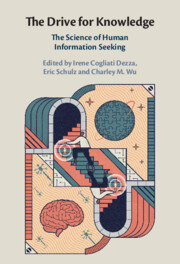Book contents
- The Drive for Knowledge
- The Drive for Knowledge
- Copyright page
- Contents
- Figures
- Tables
- Notes on Contributors
- Preface
- Part I What Drives Humans to Seek Information?
- Part II How Do Humans Search for Information?
- Chapter 5 What Makes a Good Query?
- Chapter 6 Active Inference, Bayesian Optimal Design, and Expected Utility
- Chapter 7 Exploration Beyond Bandits
- Chapter 8 Representational Exchange in Human Social Learning
- Part III Which Machinery Supports the Drive for Knowledge?
- Index
- References
Chapter 7 - Exploration Beyond Bandits
from Part II - How Do Humans Search for Information?
Published online by Cambridge University Press: 19 May 2022
- The Drive for Knowledge
- The Drive for Knowledge
- Copyright page
- Contents
- Figures
- Tables
- Notes on Contributors
- Preface
- Part I What Drives Humans to Seek Information?
- Part II How Do Humans Search for Information?
- Chapter 5 What Makes a Good Query?
- Chapter 6 Active Inference, Bayesian Optimal Design, and Expected Utility
- Chapter 7 Exploration Beyond Bandits
- Chapter 8 Representational Exchange in Human Social Learning
- Part III Which Machinery Supports the Drive for Knowledge?
- Index
- References
Summary
The ability to seek out new information is crucial in many situations of our everyday lives. In general, people can display quite elaborated exploration behavior. However, exploration has mainly been studied in multiarmed bandit tasks and theories have predominantly focused on simple directed and random exploration strategies. In this chapter, we review the results of prior studies and argue that the repertoire of human exploration strategies is much more diverse than how it is portrayed in the literature. However, to find evidence for more sophisticated strategies, more complex paradigms than multiarmed bandits are required. In particular, we argue that Markov Decision Processes offer an interesting new setting that allows us to capture strategies beyond random and directed exploration, such as empowerment-based strategies or strategies that explore using explicit goals. We conclude this chapter by discussing several new experimental paradigms that could advance our understanding of human exploration to the next level.
Keywords
- Type
- Chapter
- Information
- The Drive for KnowledgeThe Science of Human Information Seeking, pp. 147 - 168Publisher: Cambridge University PressPrint publication year: 2022
References
- 3
- Cited by



